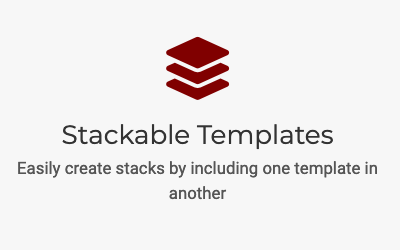Bastille Default Templates and Customization
Bastille templates are now fully native.

Bastille is an open-source system for automating deployment and management containerized applications on FreeBSD.
- Follow @BastilleBSD on Twitter
- Join the discussion BastilleBSD on Discord
- Join the discussion BastilleBSD on Telegram
- Subscribe to BastilleBSD on YouTube
- Support BastilleBSD on Patreon
Bastille Default Templates
Beginning with Bastille 0.8.20210101 the Bastillefile format is now standard
and the template system is fully native. This means that Bastille will use
default templates to apply base configuration of all new containers.
These default templates can also be customized or extended to meet your specific needs.
In this post I will outline the Bastille template system and how it is used to configure all new containers.
Template Overview
Bastille templates are simple text files defining the automation needed to configure a container. These templates can range from simple to complex. To see a list of available templates visit BastilleBSD Templates
Bastillefile
A Bastillefile is the “script” that is executed when a template is applied.
Each template will have a unique Bastillefile.
These files can also INCLUDE other Bastillefiles. This allows you to keep the
files relatively simple and organize logical components into separate
templates.
The Bastillefile template syntax follows a simple format of a Bastille
sub-command followed by its arguments. Inside a Bastillefile you do not need
to specify a TARGET. The target is defined when applying the template.
Given these simple requirements you can execute any Bastille sub-command in any
order by defining them one per line in the Bastillefile.
Simple Bastillefile Example: nginx
PKG nginx
CP usr /
SYSRC nginx_enable=YES
SERVICE nginx start
RDR 443 443
This Bastillefile would perform the following tasks:
- Install the
nginxbinary package inside the container. - Recursively copy
usrfrom the template directory into container / path. - Enable the nginx service at container startup.
- Start the nginx service in the running container.
- Redirect port 443 traffic from host into container.
Assuming the required nginx configuration files were included in the usr
directory (overlay), that container is now configured, enabled, running and
accepting traffic.
The “UPPERCASE lowercase” format is a simple visual representation of the sub-command (UPPERCASE) and the arguments to that sub-command (lowercase).
Any Bastille sub-command that targets a container can be used within a
Bastillefile.
Default Templates
As of version 0.8.20210101 Bastille ships with a handful of “default” templates. These are used to apply any default configuration to newly created containers. These “default” templates are:
- base
- empty
- thick
- thin
- vnet
These default templates are defined in the bastille.conf like so:
bastille.conf
+## Default Templates
+bastille_template_base="default/base" ## default: "default/base"
+bastille_template_empty="default/empty" ## default: "default/empty"
+bastille_template_thick="default/thick" ## default: "default/thick"
+bastille_template_thin="default/thin" ## default: "default/thin"
+bastille_template_vnet="default/vnet" ## default: "default/vnet"
If upgrading from a previous release be sure these lines have been merged into your bastille.conf
These templates are included in the installation at
/usr/local/share/bastille/templates/default.
The default base template is applied to all new containers. This base
template is applied by way of an INCLUDE statement within the other
templates.
Examples
Below is a copy of these five default templates for reference.
default/base
ARG HOST_RESOLV_CONF=/etc/resolv.conf
CMD touch /etc/rc.conf
SYSRC syslogd_flags="-ss"
SYSRC sendmail_enable="NO"
SYSRC sendmail_submit_enable="NO"
SYSRC sendmail_outbound_enable="NO"
SYSRC sendmail_msp_queue_enable="NO"
SYSRC cron_flags="-J 60"
CP "${HOST_RESOLV_CONF}" /etc/resolv.conf
default/thin
ARG BASE_TEMPLATE=default/base
ARG HOST_RESOLV_CONF=/etc/resolv.conf
INCLUDE ${BASE_TEMPLATE} --arg HOST_RESOLV_CONF="${HOST_RESOLV_CONF}"
default/thick
ARG BASE_TEMPLATE=default/base
ARG HOST_RESOLV_CONF=/etc/resolv.conf
INCLUDE ${BASE_TEMPLATE} --arg HOST_RESOLV_CONF="${HOST_RESOLV_CONF}"
default/vnet
ARG BASE_TEMPLATE=default/base
ARG HOST_RESOLV_CONF=/etc/resolv.conf
INCLUDE ${BASE_TEMPLATE} --arg HOST_RESOLV_CONF="${HOST_RESOLV_CONF}"
ARG EPAIR
ARG GATEWAY
ARG IFCONFIG="SYNCDHCP"
SYSRC ifconfig_${EPAIR}_name=vnet0
SYSRC ifconfig_vnet0="${IFCONFIG}"
# GATEWAY will be empty for a DHCP config. -- cwells
CMD if [ -n "${GATEWAY}" ]; then /usr/sbin/sysrc defaultrouter="${GATEWAY}"; fi
default/empty
As the name implies this is an empty container. No custom configuration is defined.
Template ARG
The keen observer will notice many of the default templates use the keyword
ARG to define variables. In this case:
ARG BASE_TEMPLATE=default/base
ARG HOST_RESOLV_CONF=/etc/resolv.conf
These variables can be referenced later in the template:
INCLUDE ${BASE_TEMPLATE} --arg HOST_RESOLV_CONF="${HOST_RESOLV_CONF}"
The above example variables would translate into:
INCLUDE default/base --arg HOST_RESOLV_CONF=/etc/resolv.conf
Additionally you can define and later RENDER these custom variables inside
configuration files.
Tip: The variables ${JAIL_NAME} and ${JAIL_IP} are automatically included
and can be used within container configuration files.
Example: RENDER file
PKG nginx
CP usr /
RENDER /usr/local/etc/nginx/nginx.conf
Example: RENDER directory (recursive)
PKG nginx
CP usr /
RENDER /usr/local/www
...
Customizing Default Templates
As you can see from the included default template examples, most configuration
is done in the default/base template and the other templates INCLUDE that
and (optionally) extend with additional changes.
The best way to customize the default templates is to extend them in your own
custom template. These custom templates can then be configured as the defaults
for your environment by updating the bastille.conf.
Note: In order to avoid having your changes clobbered with a Bastille package update it is not recommended to edit the default template(s) themselves.
Create a new template namespace at /usr/local/bastille/templates/. This
new template namespace is often a username or team/project name. Within this
namespace you can create new templates and extend the defaults.
Example for admin: cedwards
mkdir /usr/local/bastille/templates/cedwards/base
From here we can extend the default/base template with our own template.
Included below is an example Bastillefile that enables outbound sendmail.
cedwards/base/Bastillefile
ARG HOST_RESOLV_CONF=/etc/resolv.conf
INCLUDE default/base --arg HOST_RESOLV_CONF="${HOST_RESOLV_CONF}"
SYSRC sendmail_outbound_enable="YES"
SYSRC sendmail_msp_queue_enable="YES"
Update the bastille.conf to use cedwards/base as the new default:
bastille_template_base="cedwards/base" ## default: "default/base"
With this configuration every new container would have default/base applied
(due to the INCLUDE from cedwards/base) followed by the additional
configuration in the cedwards/base template.
Conclusion
Bastille templates are a simple and effective way to automate container creation and management. Who knew automated configuration management could be so simple?
Customizing a default template Bastillefile will allow you to change the way
every new system is configured. These defaults can be set for each main
container type and can be extended using any Bastille sub-command.